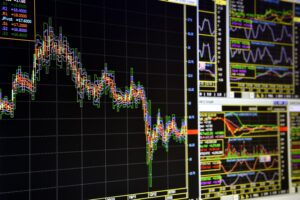
Find out 8 trading strategies every trader should know: Swing Trading, Position Trading, Day Trading, Price Action Trading, Algorithmic Trading, News Trading,etc.
Please be advised that our Client Portal is scheduled for essential maintenance this weekend from market close on Friday 5th April, 2024, and should be back up and running before markets open on Sunday 7th April, 2024.
CFDs are complex instruments and come with a high risk of losing money rapidly due to leverage. 61% of retail investor accounts lose money when trading CFDs with this provider.
You should consider whether you understand how CFDs work and whether you can afford to take the high risk of losing your money.
If you want to succeed in forex trading, you must prioritize effective risk management. This is the key to ensuring that you don’t lose your hard-earned money and can make the most of your investment.
Written by Aaron Akwu, Head of Education Hantec Markets
If you want to succeed in forex trading, you must prioritize effective risk management. This is the key to ensuring that you don’t lose your hard-earned money and can make the most of your investment. Given the volatile nature of the market, employing robust risk management techniques is vital for safeguarding investments and ensuring sustainable growth. A comprehensive assessment of data quality is crucial for identifying and mitigating potential risks that may impede profitability.
Traders heavily rely on risk management to navigate market fluctuations and unforeseen circumstances. These tools help evaluate the potential risks and enable the implementation of proactive strategies to counteract adverse market movements. Using such tools, forex traders can make informed decisions, minimize losses, and maximize gains even in market uncertainness.
One of the best strategies to manage risks in forex trading is stopping loss and setting target levels. A stop-loss order is a risk management tool that closes a trade automatically when the price reaches a certain level the trader has set. This way, the trader can limit the losses if the market moves against their expectations. A target level is a price level that the trader expects the market to reach and where they plan to take profits. By setting a target level, the trader can lock in the gains and avoid missing out on potential profits. Both stop loss and target levels should be based on a careful analysis of the identified risks, such as volatility, liquidity, and market sentiment. A risk register is a document that records and tracks the identified risks and how they are being mitigated. By using a risk register, the trader can monitor and evaluate the effectiveness of their risk management strategy. Managing risks is essential for forex traders because it can help them preserve their capital, reduce emotional stress, and improve their trading performance.

The risk-reward ratio measures how much potential profit you can make for every unit of risk you take in forex trading. It is calculated by dividing the expected return by the amount of money you are willing to lose if the trade goes against you. A higher risk-reward ratio means you aim for more profit with less risk, while a lower ratio means taking more risk for less profit.
One of the risk management tools and techniques in forex trading is risk data quality assessment, which evaluates the reliability and accuracy of the data used to identify and analyse risks. This helps to ensure that the risk assessment is based on valid and relevant information and that the risk response is appropriate and effective.
Another technique is the probability and impact matrix, which is a tool that helps to prioritise risks based on their likelihood of occurrence and their potential impact on the trading objectives. This helps to focus on the most significant risks and allocate resources accordingly.
A common way to mitigate risks is to use stop-loss orders, which are orders that automatically close your position when the market reaches a certain price level that you specify. This helps to limit your losses and protect your capital from adverse market movements.
However, not all risks are adverse. Some risks can have positive outcomes, such as unexpected market opportunities or favourable price movements. These are called positive risks, and they can be exploited by using take-profit orders, which are orders that automatically close your position when the market reaches a certain price level that you specify. This helps to lock in your profits and avoid missing out on potential gains.

Position size is one of the most critical aspects of risk management in forex trading. It refers to the amount of money a trader invests in a single trade, expressed in lots or units. By choosing the appropriate position size, traders can control their exposure to market fluctuations and avoid risking too much of their capital.
One of the techniques to determine the optimal position size is to use a risk assessment template. This tool helps traders identify each trade’s potential risks and rewards based on factors such as account size, risk tolerance, stop loss level, and currency pair volatility. A risk assessment template can also help traders prioritize risks by ranking them according to their probability and impact.
Another technique to calculate the position size is to use a forex risk management calculator. This tool automates the position sizing process by considering the same factors as the risk assessment template and providing a precise position size in lots or units. A forex risk management calculator can save time and reduce errors for traders.
Risk management is a critical component in the realm of forex trading, akin to its importance in project management. Effective risk management in this context involves meticulous planning and implementing various tools and techniques to ensure capital preservation and long-term success. One such key practice is carefully considering risk per trade, which involves assessing the potential loss on a single trade and setting a predefined limit to safeguard against significant losses. By adhering to this principle, traders can balance the pursuit of profits and the necessity of managing risk, ultimately fostering a sustainable and robust trading strategy.
Several essential rules and techniques are effective risk management tools in this volatile market. First and foremost, setting a stop-loss order is imperative to limit potential downside risk. Additionally, diversifying one’s portfolio across different currency pairs can help spread risk and prevent overexposure to any single currency. Moreover, employing position sizing strategies based on the risk-reward ratio can ensure that potential profits outweigh potential losses. Regularly monitoring and assessing market conditions and staying informed about geopolitical events and economic indicators are also integral parts of a comprehensive risk management plan. By adhering to these rules and techniques, traders can navigate the forex market with greater control and stability, making risk management important in every aspect of their trading journey.
Leverage and margin are pivotal tools in forex trading, allowing investors to control larger positions with limited capital. While they can amplify profits, they also magnify losses, making risk management important. Using leverage, traders can open positions that exceed their initial investment, increasing potential gains. However, it’s crucial to be cautious as higher leverage raises the risk of significant losses. Margin, on the other hand, serves as collateral, ensuring that traders can cover potential losses. Setting appropriate leverage levels and maintaining sufficient margins can be instrumental in safeguarding one’s forex investments, making effective risk management important for sustainable trading success.

Find out 8 trading strategies every trader should know: Swing Trading, Position Trading, Day Trading, Price Action Trading, Algorithmic Trading, News Trading,etc.

This article provides an overview of exit strategies in trading and why they are essential for long-term success.

Whether you are a novice or an experienced trader, the knowledge within these books is a valuable resource for navigating the complexities of the financial markets.
Risk Warning
CFDs are complex instruments and come with a high risk of losing money rapidly due to leverage. 61% of retail investor accounts lose money when trading CFDs with this provider. You should consider whether you understand how CFDs work and whether you can afford to take the high risk of losing your money.
Please click here to view our Risk Disclosure.
Hantec Markets use cookies to enhance your experience on our website. By staying on our website you agree to our use of cookies.
You can access our Cookie Policy here
Risk Warning
CFDs are complex instruments and come with a high risk of losing money rapidly due to leverage.
You should consider whether you understand how CFDs work and whether you can afford to take the high risk of losing your money.
Please click here to view our Risk Disclosure.
Hantec Markets use cookies to enhance your experience on our website. By staying on our website you agree to our use of cookies. You can access our Cookie Policy here
Hantec Markets is a trading name of Hantec Group.
This website is owned and operated by Hantec Markets Holdings Limited. Hantec Markets Holdings Limited is the holding company of Hantec Markets Limited and Hantec Markets Ltd.
Hantec Markets Limited is authorised and regulated by the Financial Conduct Authority (FCA) in the UK (Register no: FRN 502635).
Hantec Markets Ltd. is authorised and regulated as an Investment Dealer by The Financial Services Commission of Mauritius (License no: C114013940).
The services of Hantec Markets and information on this website are not aimed at residents of certain jurisdictions, and are not intended for distribution to, or use by, any person or entity in any jurisdiction or country where such distribution or use may be contrary to any of the laws or regulations of that jurisdiction. The products and services described herein may not be available in all countries and jurisdictions. Those who access this site do so on their own initiative, and are therefore responsible for compliance with applicable local laws and regulations. The release does not constitute any invitation or recruitment of business.
Hantec Markets does not offer its services to residents of certain jurisdictions including the USA, Iran, Myanmar, North Korea and the United Arab Emirates.

Lorem ipsum dolor sit amet, consectetur adipiscing elit. Ut elit tellus, luctus nec ullamcorper mattis, pulvinar dapibus leo.
Lorem ipsum dolor sit amet, consectetur adipiscing elit. Ut elit tellus, luctus nec ullamcorper mattis, pulvinar dapibus leo.
Lorem ipsum dolor sit amet, consectetur adipiscing elit. Ut elit tellus, luctus nec ullamcorper mattis, pulvinar dapibus leo.


We are transferring you to our affiliated company Hantec Trader.
Please note: Hantec Trader does not accept customers from the USA or other restricted countries.